Storing sulfuric acid needs careful thought about its properties and dangers. Why is storing sulfuric acid so important? How can we make sure it’s stored safely? The key is to understand the details of sulfuric acid storage, from its chemical makeup to legal rules. Proper storage of sulfuric acid is key to avoiding accidents and following the law. To store sulfuric acid right, we must look at safety rules and storage needs.
Click to use Silverigroup personal shopper services
Key Takeaways:
- Knowing sulfuric acid’s properties is key for safe storage
- Proper storage of sulfuric acid requires careful thought of its reactivity and dangers
- Sulfuric acid storage must follow legal rules and regulations
- Safe storage of sulfuric acid means using approved containers and following specific guidelines
- Regular checks and upkeep are needed to keep sulfuric acid storage facilities safe
- Training employees and safety procedures are vital for preventing accidents and following the rules
Understanding Sulfuric Acid Properties
Handling sulfuric acid safely means knowing its properties well. It’s a strong acid with the formula H2SO4. It looks like a clear, odorless syrup and dissolves in water. Always wear protective gear when working with it to avoid accidents. Knowing sulfuric acid’s properties helps us choose the right safety gear. Its chemical makeup and how it reacts tell us what materials to use for storage and handling. This knowledge is key to safely storing and using sulfuric acid.
Click to buy citric acid from Silvairgroup
Chemical Composition and Reactivity
Sulfuric acid’s chemical makeup makes it very reactive. It can react with metals and other substances, releasing harmful gases. Always wear protective gear and follow safety rules to avoid these gases.
Physical Characteristics
Sulfuric acid is thick and heavy, posing a risk if not handled right. Its syrupy texture and density can cause serious burns. So, it’s important to handle and store it carefully.
Common Industrial Uses
Sulfuric acid is used in making fertilizers, chemicals, and medicines. In these fields, following strict safety rules is crucial. By understanding sulfuric acid’s properties and taking safety measures, industries can handle it safely.
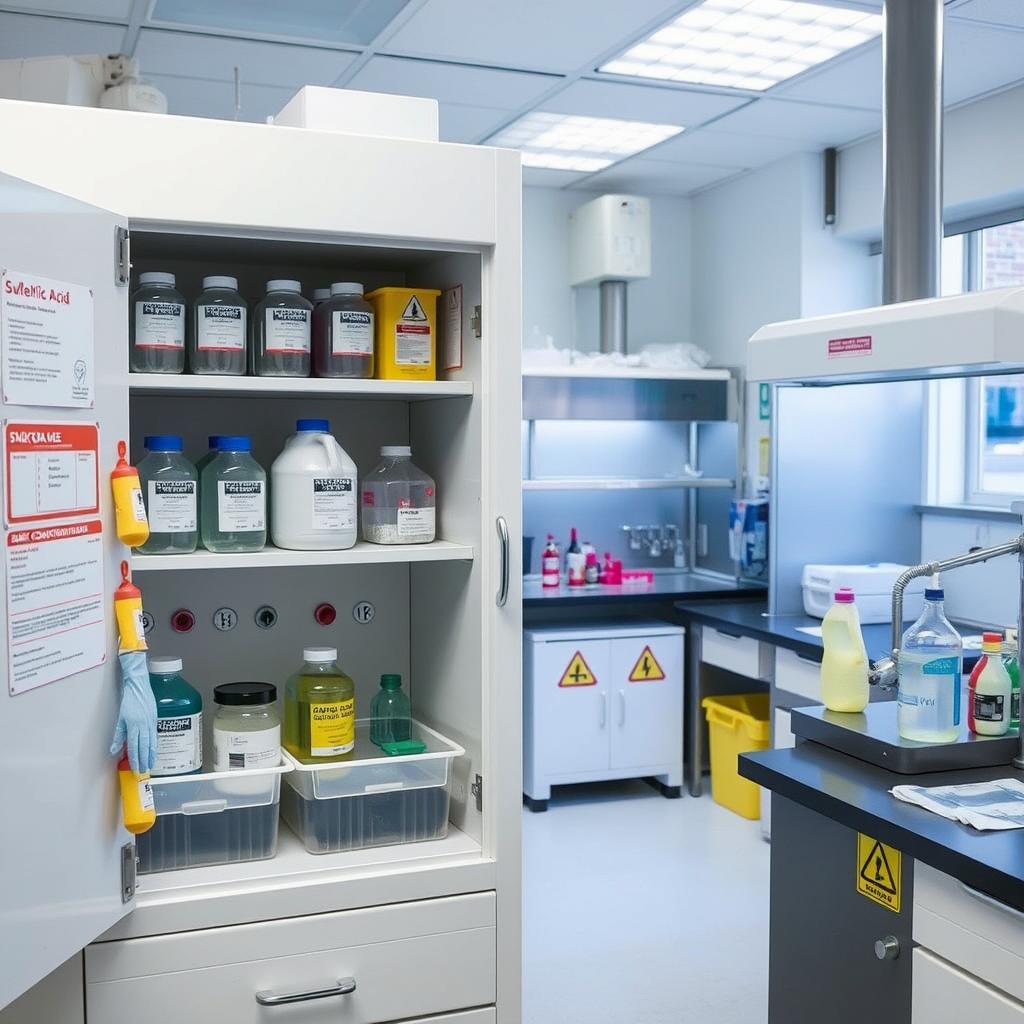
Essential Safety Gear for Handling Sulfuric Acid
When working with sulfuric acid, wearing the right safety gear is key. Sulfuric acid chemical storage requirements stress the need for protective equipment. This ensures safe handling of the acid. The must-have safety gear includes:
- Gloves: to prevent skin contact with the acid
- Goggles: to protect the eyes from splashes
- Face shields: to prevent acid from coming into contact with the face
- Protective clothing: to prevent skin contact and splashes
Click to buy frozen a grade beluga fish from Silverigroup
Using the right safety gear is crucial to avoid acid burns. By following sulfuric acid chemical storage requirements, you can lower the risks of handling this dangerous chemical. It’s also important to check and keep the safety gear in good condition. This ensures it works well to prevent injuries. By focusing on safety and following sulfuric acid chemical storage requirements, you can handle sulfuric acid safely and reduce risks.
| Safety Gear | Importance |
|---|---|
| Gloves | Prevents skin contact with the acid |
| Goggles | Protects the eyes from splashes |
| Face shields | Prevents acid from coming into contact with the face |
| Protective clothing | Prevents skin contact and splashes |
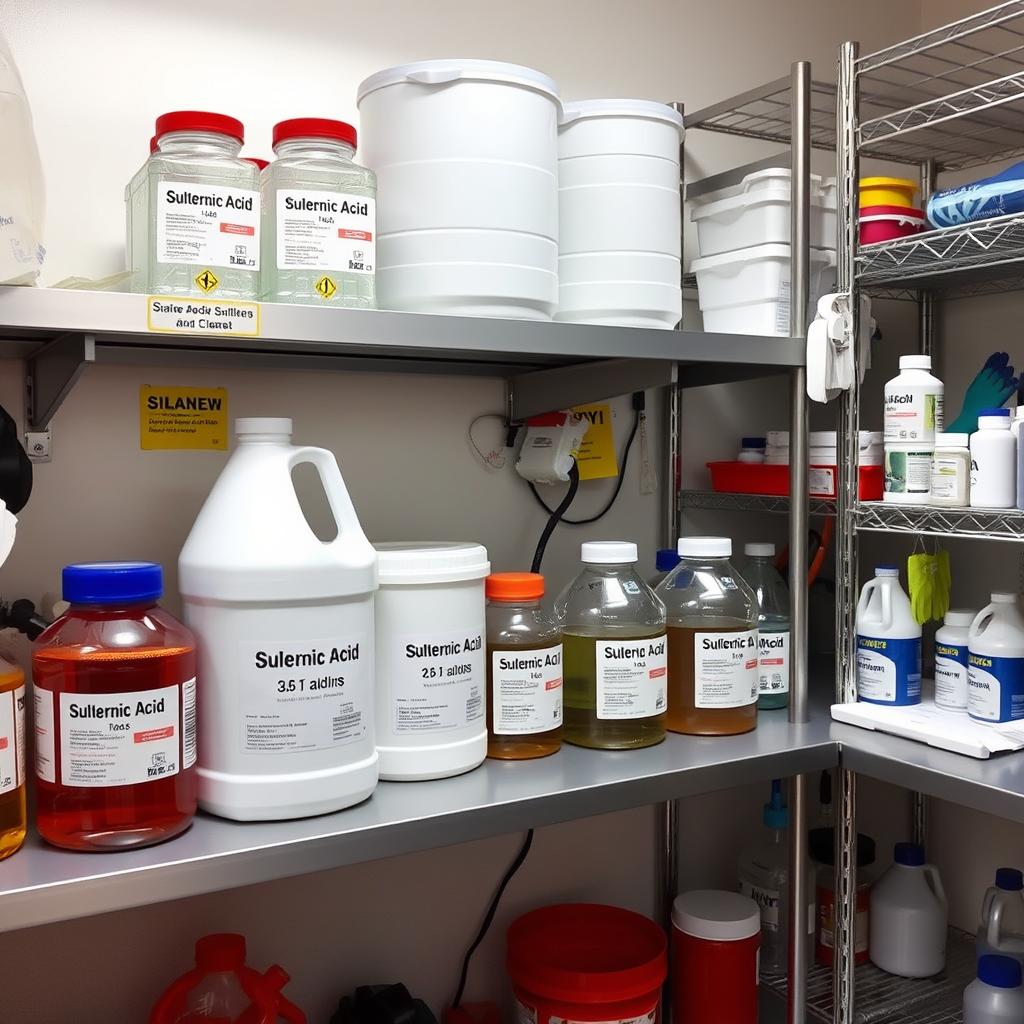
Proper Container Requirements to Store Sulfuric Acid
Storing sulfuric acid safely requires the right containers. These containers must be made of materials like glass or high-density polyethylene. They should also be designed for corrosive substances. This helps prevent leaks and ensures safe storage. Choosing the correct containers is very important. Corrosion-resistant materials are key because they can handle sulfuric acid’s acidity. Containers should also have safety features like tight lids and secure handles. This helps avoid accidents and spills. Some important things to consider for safe storage include:
- Using containers made for corrosive substances
- Choosing materials like glass or high-density polyethylene
- Labeling containers properly to warn others
By following these tips and using the right containers, you can store sulfuric acid safely. This reduces the chance of accidents and protects the environment.
| Container Material | Compatibility | Safety Features |
|---|---|---|
| Glass | Compatible with sulfuric acid | Tight-fitting lids, secure handles |
| High-density polyethylene | Compatible with sulfuric acid | Tight-fitting lids, secure handles |
Storage Area Specifications and Requirements
Storing sulfuric acid safely requires a well-designed storage area. It should be well-ventilated and away from harmful substances. A spill containment system is also essential to prevent accidents. Some key considerations for storing sulfuric acid safely include:
- Well-ventilated area to prevent the accumulation of toxic fumes
- Away from incompatible substances to prevent chemical reactions
- Spill containment system to mitigate potential risks
By following these guidelines, individuals can ensure that they are storing sulfuric acid safely and reducing the risk of accidents. Proper storage area design is essential in preventing accidents and ensuring the safe storage of sulfuric acid. It is also important to note that storing sulfuric acid safely requires careful planning and attention to detail.
In addition to proper storage area design, it is also important to consider the use of secondary containment systems and spill kits. These can help to mitigate potential risks and prevent accidents. By taking a proactive approach to storing sulfuric acid safely, individuals can help to ensure a safe and healthy work environment.
| Storage Area Requirement | Description |
|---|---|
| Well-ventilated area | Prevents the accumulation of toxic fumes |
| Away from incompatible substances | Prevents chemical reactions |
| Spill containment system | Mitigates potential risks |
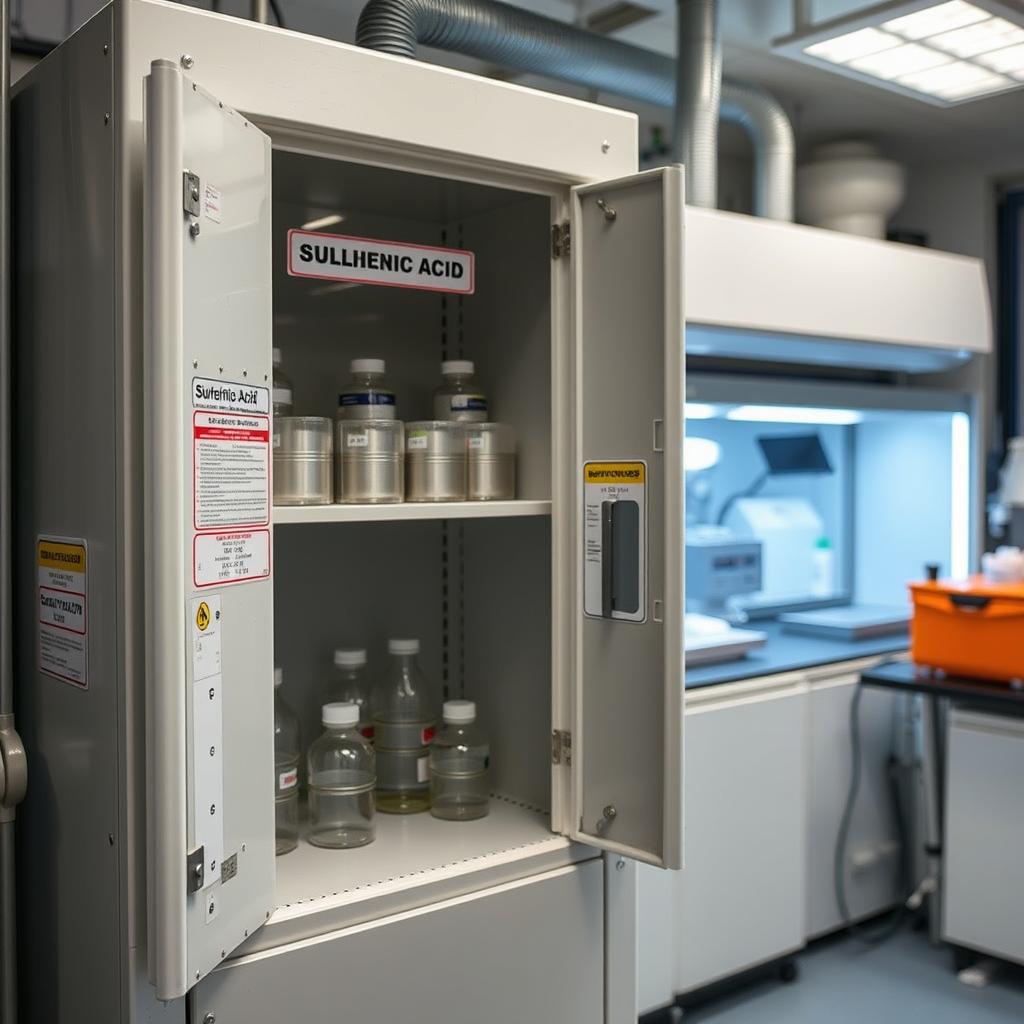
Temperature Control and Environmental Factors
When learning how to store sulfuric acid, it’s key to think about the environment. Store it in a cool, dry spot, away from sunlight and heat. This helps keep the acid and containers safe. Keeping the temperature right is crucial. The best range is between 60°F and 80°F (15°C and 27°C). If it’s too hot or cold, the acid can break down or become dangerous.
Optimal Temperature Range
Keeping the acid at the right temperature is very important. Store it in a place with good air flow, away from sunlight and heat. Make sure the area doesn’t have big temperature swings.
Humidity Considerations
Humidity also plays a big role in storing sulfuric acid. High humidity can make the acid more concentrated, increasing the risk of accidents. Keep it in a dry, well-ventilated area to avoid these problems.
Ventilation Requirements
Good air flow is essential when storing sulfuric acid. The area should be well-ventilated to avoid fume buildup. Use ventilation systems or natural air flow to control the environment. By managing temperature and environment, you can safely store sulfuric acid.
Segregation from Incompatible Materials
Storing sulfuric acid safely means keeping it away from materials that could react with it. This is to avoid accidents. You need to know which materials can’t be near sulfuric acid, like bases, certain metals, and organic stuff.
Some things you shouldn’t mix with sulfuric acid include:
- Bases, such as sodium hydroxide or calcium hydroxide
- Metals, such as aluminum or magnesium
- Organic materials, such as wood or cotton
These can cause problems like heat release, gas, or even explosions. So, it’s key to sulfuric acid storage in a place where these materials can’t get to it. Keeping sulfuric acid away from these materials helps avoid accidents. This is crucial when you have a lot of it or people around. It makes sure everyone stays safe. It’s not just about segregation. You also need to handle and store sulfuric acid the right way. Use approved containers, label them well, and keep them in a place with good air flow. Following these steps helps keep sulfuric acid safe and prevents accidents.
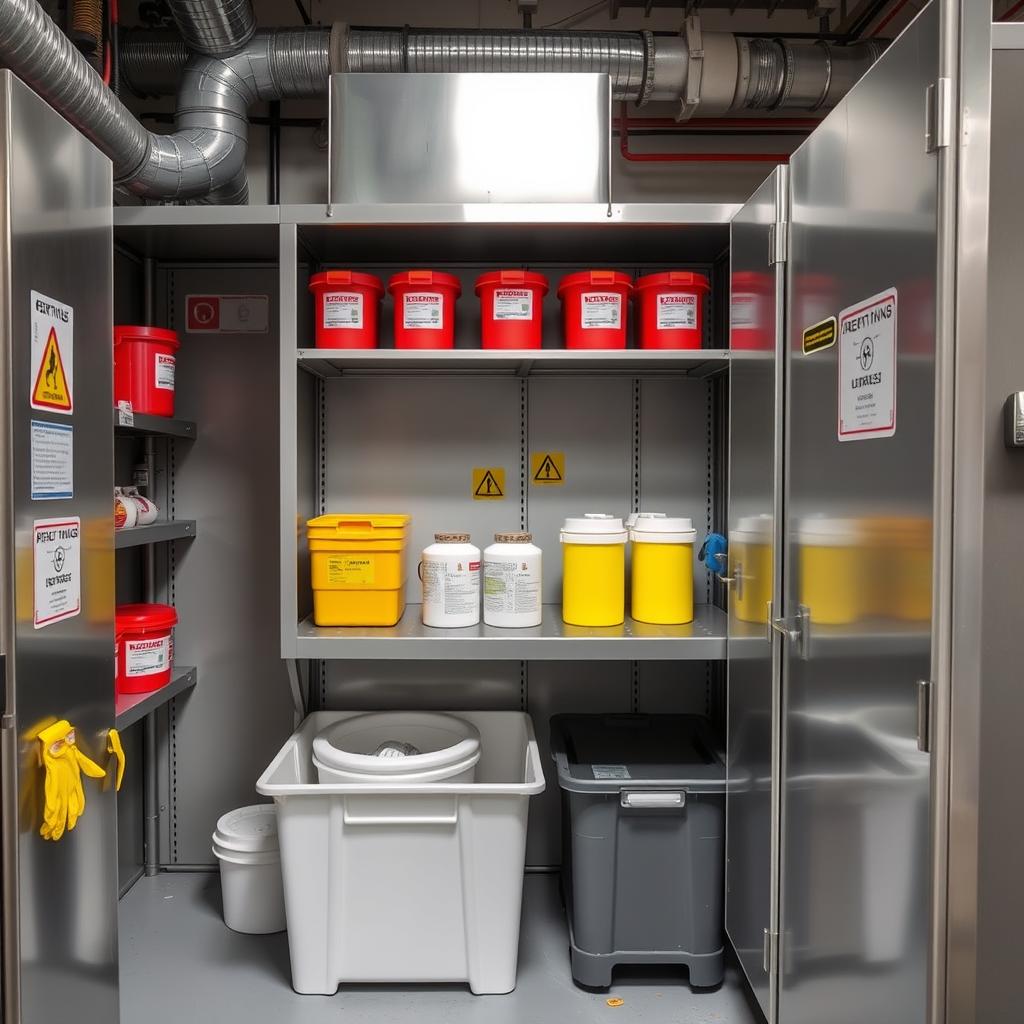
Spill Prevention and Containment Measures
Handling sulfuric acid requires careful safety steps to avoid spills and manage them if they happen. Spills can be dangerous, causing harm and environmental damage. It’s vital to have a plan for spill prevention and containment. To prevent spills, using secondary containment systems is key. These systems add an extra layer of safety. They include dikes, berms, or barriers to stop acid from spreading.
Secondary Containment Systems
Secondary containment systems are made to hold spills and keep them from getting into the environment. They must be strong enough to handle sulfuric acid’s corrosive effects.
Spill Kit Requirements
A spill kit is crucial for quick and effective spill response. It should have absorbents, neutralizing agents, and protective gear. The kit must be easy to find and checked often to make sure it’s ready.
Emergency Response Procedures
Having emergency plans for spills is essential. These plans should cover evacuation, first aid, and spill cleanup. Everyone working with sulfuric acid must know these procedures to act fast and right. By following these steps, handling sulfuric acid safely becomes easier. Remember, safety is key to avoiding accidents and protecting our environment.
| Spill Prevention Measures | Description |
|---|---|
| Secondary Containment Systems | Provide an extra layer of protection in case of a spill |
| Spill Kits | Include materials for responding to spills quickly and effectively |
| Emergency Response Procedures | Include evacuation protocols, first aid procedures, and a plan for containing and cleaning up the spill |
Regular Inspection and Maintenance Protocols
Regular checks are key to keeping sulfuric acid storage safe and sound. Facilities must follow a set schedule for these inspections. They need to look for damage on containers, check labels, and make sure safety gear works. Important things to watch during these checks include:
- Container condition: Look for wear, corrosion, or damage that could weaken the container.
- Labeling and signage: Make sure containers are labeled right and safety signs are clear.
- Safety equipment: Check that gloves, goggles, and spill kits are ready and in good shape.
Following these steps helps keep facilities safe. Regular maintenance is also vital. It stops equipment from breaking down and keeps systems running right. Putting a focus on regular checks and upkeep is crucial. It keeps facilities in line with storage rules and keeps everyone safe. This protects workers and prevents big problems and environmental damage.
Employee Training and Safety Procedures
It’s key to train employees who work with sulfuric acid. They need to know how to handle it safely. This includes learning about sulfuric acid containment and proper sulfuric acid storage. They should also learn about personal protective equipment and emergency plans. It’s important to follow safety rules. A trained team is vital for safe work. They need to know about sulfuric acid’s dangers. This includes its chemical makeup and health risks. They must also learn how to handle and store it right. This includes using the right containers and labels.
Required Certifications
Workers with sulfuric acid need the right certifications. These include training in handling hazardous materials and emergency response.
Emergency Response Training
Regular training on emergency plans is a must. This includes how to deal with spills and evacuations. Hands-on practice helps prepare them for real emergencies.
Documentation Requirements
Keeping accurate training records is important. This includes certifications, training dates, and what was covered. It helps meet regulations and track training. Training employees well helps reduce risks with sulfuric acid containment and proper sulfuric acid storage. They learn how to handle it safely and what to do in emergencies.
Transportation and Transfer Guidelines
Storing sulfuric acid safely means paying close attention to how it’s moved and transferred. We aim to avoid accidents and follow the rules. Using the right containers and following transportation laws is key. Transporting and transferring sulfuric acid safely involves several important steps. These include proper labeling of containers, secure loading and unloading procedures, and regular inspection of equipment. This helps prevent leaks or spills. Following these guidelines can greatly reduce risks.
Some key steps for transporting and transferring sulfuric acid include:
- Using approved containers that are specifically designed for storing sulfuric acid safely
- Ensuring that all equipment is in good working condition and regularly inspected
- Following relevant transportation regulations and guidelines
- Providing proper training to personnel involved in the transportation and transfer process
By following these steps, we can ensure sulfuric acid is stored safely. This reduces the chance of accidents and environmental harm. Remember, storing sulfuric acid safely is a big responsibility. It requires careful attention and a commitment to safety guidelines. By prioritizing safety, we can prevent accidents and keep our work environment safe.
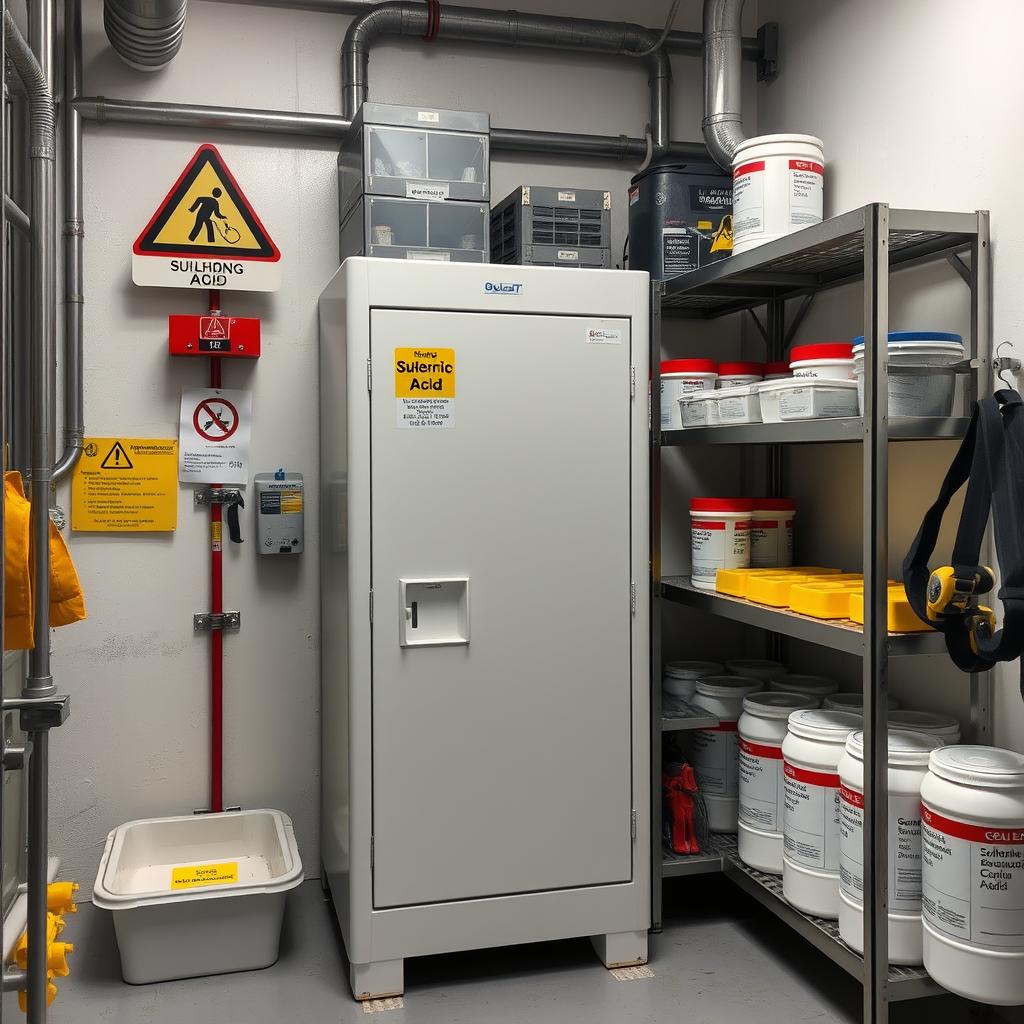
Legal Requirements and Compliance Standards
Understanding how to store sulfuric acid is key. You need to follow federal laws like OSHA and EPA. This keeps storage safe and avoids legal trouble. To store sulfuric acid right, follow certain rules. These include:
- Compliance with OSHA regulations
- Adherence to EPA standards
- Industry-specific guidelines
Remember, laws can change by state. It’s up to you or your group to check if you’re following all rules. Following these standards keeps sulfuric acid safe and prevents dangers. By sticking to these rules, you make sure sulfuric acid is stored safely. This action prevents accidents, protects the environment, and keeps people healthy.
| Regulation | Description |
|---|---|
| OSHA | Occupational Safety and Health Administration regulations for safe handling and storage |
| EPA | Environmental Protection Agency standards for environmental protection and safety |
Conclusion: Ensuring Long-term Safety in Sulfuric Acid Storage
Keeping sulfuric acid storage safe for the long term is crucial. It needs a strong focus on safety rules, regular training for employees, and following all laws. This way, companies can keep their work safe and protect their workers from harm. It’s important to check things regularly, use the right safety equipment, and have good plans for spills. Also, keeping the acid away from things it shouldn’t be near and controlling its temperature are key. By following these steps, companies can create a safe and compliant work environment. This ensures their operations stay safe for a long time.
FAQ: How to store sulfuric acid
What are the essential safety gear requirements for handling sulfuric acid?
To handle sulfuric acid safely, you need gloves, goggles, face shields, and protective clothing. These items help prevent acid burns and ensure safe handling.
What are the approved container materials for storing sulfuric acid?
Store sulfuric acid in containers made of glass or high-density polyethylene. These materials resist corrosion and leakage, keeping the acid safe.
What are the storage area specifications and requirements for sulfuric acid?
The storage area for sulfuric acid must be well-ventilated and away from incompatible substances. It should also have a spill containment system to prevent accidents.
What are the temperature control and environmental factors to consider when storing sulfuric acid?
Store sulfuric acid in a cool, dry place, away from sunlight and heat. The right temperature and ventilation are key to preventing acid degradation.
How should sulfuric acid be segregated from incompatible materials?
Keep sulfuric acid away from bases, metals, and organic materials to avoid chemical reactions. Proper segregation is vital for safe storage.
What are the spill prevention and containment measures for sulfuric acid?
Use secondary containment systems and have spill kits ready. Follow emergency response procedures in case of a spill to minimize risks.
What are the regular inspection and maintenance protocols for sulfuric acid storage facilities?
Regularly check containers for damage, ensure proper labeling, and verify safety equipment functionality. Maintaining the facility is key for ongoing safety and compliance.
What are the employee training and safety procedures required for handling sulfuric acid?
Employees must receive training on safety procedures, emergency response, and personal protective equipment use. This ensures a safe and compliant workforce.
What are the transportation and transfer guidelines for sulfuric acid?
Transport and transfer sulfuric acid in approved containers and equipment, following relevant regulations. This prevents accidents and ensures compliance.
What are the legal requirements and compliance standards for storing sulfuric acid?
Follow OSHA regulations, EPA standards, and industry guidelines for storing sulfuric acid. Adherence to these regulations is essential for safe storage and avoiding legal issues.

